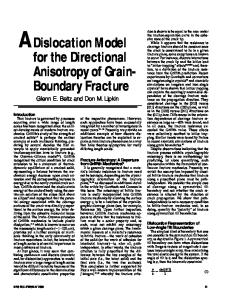Dislocation emission criterion: Grain boundary effect
- PDF / 398,773 Bytes
- 5 Pages / 576 x 792 pts Page_size
- 42 Downloads / 405 Views
Tong-Yi Zhang Department of Mechanical Engineering, Hong Kong University of Science and Technology, Kowloon, Hong Kong
Sanboh Lee Department of Materials Science and Engineering, National Tsing Hua University, Hsin-Chu, Taiwan, Republic of China (Received 30 October 1992; accepted 7 April 1993)
Based on the results of Shiue and Lee [J. Appl. Phys. 70, 2947 (1991)], the effect of plastic zone and grain boundary on the dislocation emission criterion was investigated. The emission criterion is based on the concept of spontaneous emission. The critical stress intensity factor for dislocation emission increases with the increasing size of dislocation-free zone and the number of piled-up dislocations in the plastic zone, but decreases with increasing grain size. The ductile versus brittle behavior of material was determined by the competition of critical stress intensity factors for dislocation emission and crack propagation. A material with larger grain size is easier to emit dislocation and allows more dislocations to be piled up, so that it behaves more ductile.
I. INTRODUCTION The pileup of dislocations in the vicinity of a crack tip affects the ductile versus brittle behavior of material so that much attention has been paid to this topic. Armstrong2 and Kelly, Tyson, and Cottrell3 considered the brittle versus ductile behavior of materials as the competition between Griffith cleavage and plastic shear at a crack tip. Bilby, Cottrell, and Swinden (BCS)4 simulated the plastic zone by continuous dislocations in which the dislocations were emitted from the crack tip without energy barrier so that no dislocation-free zone appeared. The energy barrier was first proposed by Rice and Thomson.5 Majumdar and Burns6 and Chang and Ohr7 modified the BCS model to allow an energy barrier for dislocation emitted from the crack tip. Dai and Li 8 suggested that the energy barrier is a necessary condition for a dislocation-free zone observed at the crack tip.9 The common feature of the above studies was that the energy barrier or the critical stress intensity factor for spontaneous dislocation emission was considered as a material parameter. On the other hand, Rice10 and Schoeck11 analyzed the dislocation generation from the crack tip based on the Peierls concept in which the emitted dislocation was not allowed to be fully formed at the crack tip prior to the instability. Brock12 investigated the transient phenomenon for a micromechanical process of dislocation emission from stationary cracks subjected to plane wave diffraction in which the emission criterion was similar to that developed for spontaneous dislocation emission. Zhou and Thomson13 proposed that ledges on cracks can be an efficient source of dislocations at J. Mater. Res., Vol. 8, No. 8, Aug 1993
http://journals.cambridge.org
Downloaded: 05 Apr 2015
loading well below the critical loading for spontaneous emission. Zhang14 and Shiue and Lee15 studied that the energy barrier or critical stress intensity factor for spontaneous dislocation emission was a function of dis
Data Loading...











